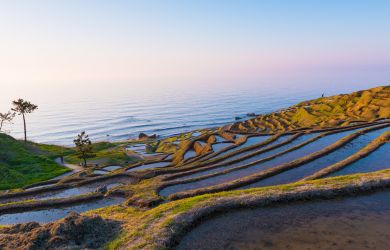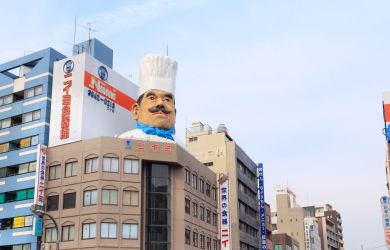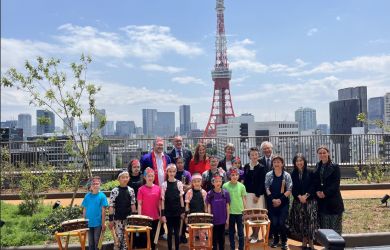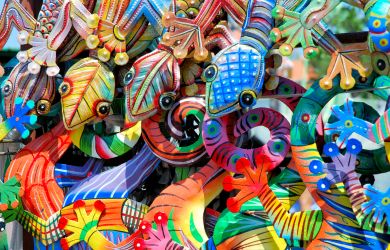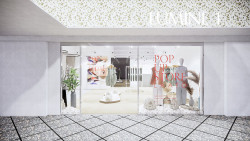
September 30, 2010
Sensing Nature
The Mori scales up a show of small ideas to fill a big space
By Metropolis
Originally published on metropolis.co.jp on September 2010

Model of Oblivion, 2006–2010, Taro Shinoda, mixed media, 457.5 x 260 x 183cm
What happens when you take a few interesting but rather limited artistic ideas on the theme of “nature” and then completely over-amplify them? Probably something like “Sensing Nature,” a new exhibition at the Mori Art Museum that threatens to “rethink the Japanese perception of nature.”
The traditional Japanese sense of the natural world is justifiably famous—animism, an enhanced appreciation of the changing seasons, gardens as microcosms of the cosmos, etc., etc.—so why mess with a winning formula? If only this exhibition had the power to do so, it would at least be interesting. Yet the three talents assembled for the show—Tokujin Yoshioka, Taro Shinoda and Takashi Kuribayashi—comprise one designer and two conceptual artists. Not the most promising selection for a big exhibition like this.
The first installation tries hard to impress. Yoshioka’s Snow (2010) is a 14-meter-long tank filled with millions of feathers, occasionally blown by a large fan. The effect is to mimic snowfall, and with the recent heat wave we’ve endured here in Tokyo, the thought is at least a pleasant and timely one. Elsewhere, Yoshioka’s glass and crystal works seem to fit the same pattern but, lacking the grandeur and motion of Snow, they are instantly forgettable. This suggests that Snow itself might be, too, if it weren’t quite so big.
Shinoda’s Reverberation (2010) is next, but it entirely fails to live up to its title. Three dull, ten-minute videos are projected onto entire walls of the museum: a tapir wanders around, a camera moves down a canal in Tokyo, we see a lake, etc. Once again, small ideas are amplified out of all proportion to their inherent value.
A brief flicker of interest is provided by Shinoda’s next installation, Model of Oblivion (2006). A large block of what initially looks like marble, but is probably white plastic or wax, appears to bleed, with red liquid spreading out across a large white table. According to the catalogue, this is supposed to “allude to” ancient Chinese views of the cosmos, but rather than relying on such sophistry, this work appeals at a more visceral level. It is visually dramatic, yet once again, the vast scale of the piece heightens the effect.
The most talented of the three participants is Takashi Kuribayashi, an artist whose eight years in Germany seem to have given him a bit more edge, while at the same time lumbering him with curatorial cant about his work hinting at “the fluidity of boundaries.” Nothing of the kind, as Forest from Forest (2010) makes clear.
Using thick Japanese paper and bits of wood, Kuribayashi has created a forest landscape that visitors enter from below and view by putting their heads up through holes, rather like rabbits. If the boundary in this case is ground level, the difference between the two worlds—above and below ground—is stark and rigid. This work also succeeds in turning the audience into part of the display, as we watch other visitors’ reactions.
Less impressive is Kuribayashi’s final piece, Islands (2010). This presents the not exactly groundbreaking idea that islands actually sit atop mountains. By bringing several tons of soil up to the 53rd floor of Roppongi Hills to drive home this point, the artist has created yet another work that impresses more by its bulk than its content.
The amount of artistic insight at this exhibition might perhaps have been enough to make a rather good show in a much smaller gallery, but that would also have meant scaling everything back down to the actual size of the ideas.
Mori Art Museum
Tokujin Yoshioka, Taro Shinoda and Takashi Kuribayashi. Sensing Nature: Rethinking the Japanese Perception of Nature. Various media. Until Nov 7, ¥500 (MS and under)/¥1,000 (HS, univ)/¥1,500 (adult). MAM Project 012: Tromarama. Video installation. Until Nov 7, free (with Sensing Nature admission). Mori Tower Roppongi Hills, 6-10-1 Roppongi, Minato-ku. Tel: 03-5777-8600. Open Wed-Mon 10am-10pm, Tue 10am-5pm. Nearest stn: Roppongi. www.mori.art.museum/eng
